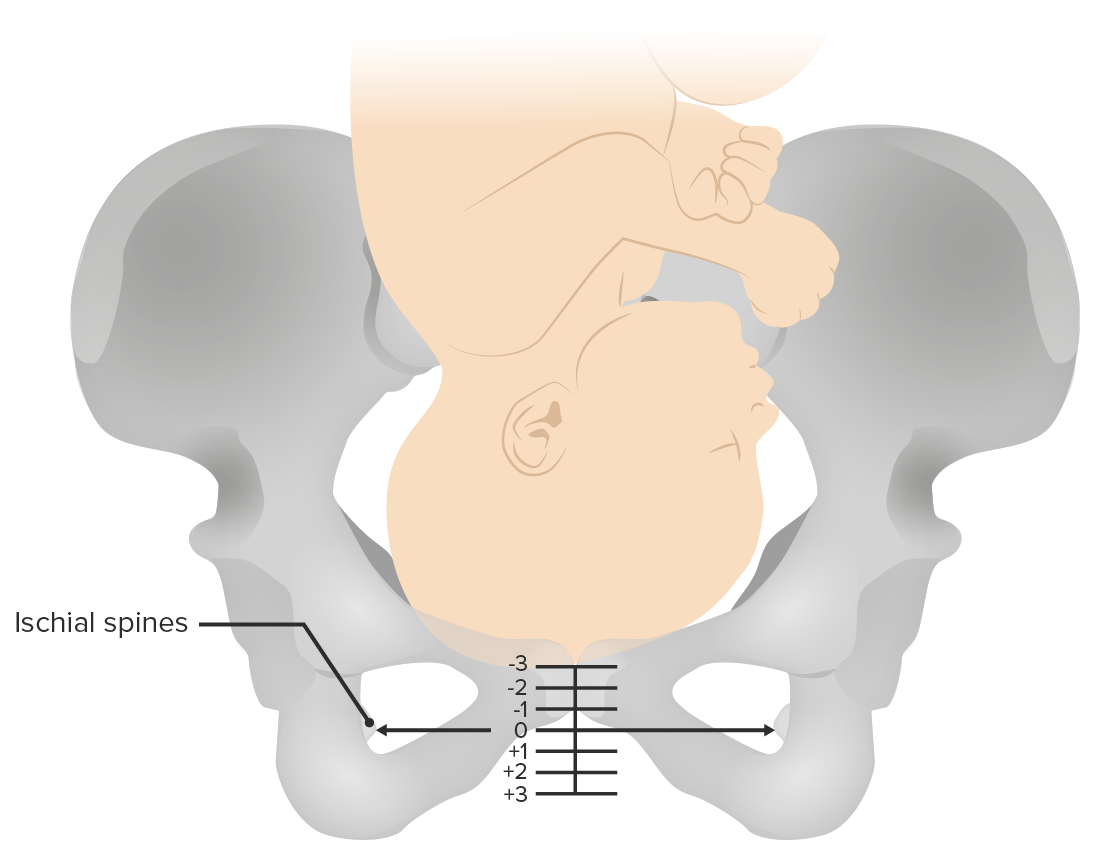Playlist
Show Playlist
Hide Playlist
Labor Stage 2: Normal and Abnormal Labor
-
Slides NormalAbnormalLabor Obstetrics.pdf
-
Download Lecture Overview
00:01 Now let's discuss the second stage of labor. 00:06 First, let's review all of our stages of labor. 00:09 Stage 1 starts with the onset of labor until 10 centimeters dilated. 00:14 Stage 2 starts with 10 centimeters dilated and it ends with the delivery of the fetus. 00:19 And then stage 3 starts with the delivery of the fetus and ends with the delivery of the placenta. 00:26 So it's important to know that during stage 2, the fetus is entering the pelvis through the cardinal movements of labor which begin in stage 1 and are completed in stage 2. 00:38 Now let's review the cardinal movements of labor. 00:41 First there is engagement, that's when the head enters the pelvis. 00:45 Then there's descent, that is as the fetus starts to descend into the pelvis. 00:50 Then there is flexion. 00:52 Because of the pelvis the fetal chin will go against the chest to have the fetal vertex enter into the pelvis. 00:58 Then there is internal rotation as the head starts to turn. 01:04 Then there's extension as the head goes underneath the mom's pubic symphysis. 01:08 And then there is external rotation where the head will go back to the original rotation. 01:13 And then expulsion, and the fetus is delivered. 01:16 Now if you have a little trouble, remembering all of these maneuvers, here's another metaphor that may help you. 01:22 So you may think of it like a wedding. 01:25 First you get engaged. 01:27 Then you descend down the aisle. 01:29 Then you flex your head to pray. 01:31 Then you turn towards your spouse. 01:33 You lift your head back up. 01:35 You kiss each other. 01:37 Then you externally rotate or turn towards the congregation. 01:41 And then you walk down on the aisle. 01:43 And that's the expulsion. 01:44 I hope that helps you remember these steps. 01:48 Now for stage 2, what are parameters for normal labor? In our primiparous patient with an epidural, we expect that baby to be pushed out within 3 hours. 01:58 For multiparous mom 2 hours. 02:01 Without an epidural for primiparous mom, the baby should be pushed within 2 hours. 02:06 And for our multiparous mom without an epidural, we expect the baby to come out within 1 hour. 02:12 A stage 2 progresses but takes longer than the expected parameters we have listed here. 02:18 This is considered a protracted second stage. 02:20 If there is no descent for more than 2 hours, this is considered an arrest of the second stage of labor. 02:27 So abnormal labor in the second stage is considered an arrest. 02:34 When that occurs, an operative delivery must happen. 02:37 If the fetus is less than +2 station, meaning the head is higher than +2 station then you would proceed with a cesarean delivery. 02:46 If the head is below +2 station and all the other parameters are met an operative vaginal delivery can happen. 02:54 That's discussed in another lecture.
About the Lecture
The lecture Labor Stage 2: Normal and Abnormal Labor by Veronica Gillispie, MD, MAS, FACOG is from the course Intrapartum Care. It contains the following chapters:
- Second Stage of Labor
- Stage 2 – Normal Labor
- Stage 2 – Abnormal
Included Quiz Questions
A 31-year-old G2P1 with a history of a c-section for her first child is admitted to the labor ward at 41 weeks gestation for spontaneous onset of labor. She progressed through the active phase of the first stage of labor over 3 hours and her last cervical exam showed a completely dilated cervix and at -1 station. She was allowed 1 hour for passive descent and then pushed with adequate effort and contractions for 2 hours. Repeat cervical exams during this period demonstrated no change in the station of the fetus. She feels like this baby is about the same size as her last. What is the likely cause of this situation, and what should be the next step in management?
- Arrest of labor due to fetal malpresentation or fetal-pelvic disproportion; cesarean section should be the next step.
- Arrest of labor due to fetal malpresentation or fetal-pelvic disproportion; operative vaginal delivery should be the next step.
- Protracted second stage of labor due to fetal malpresentation; allow for another 1 hour of passive descent and rest to avoid maternal exhaustion.
- Protracted second stage of labor due to pelvic disproportion; operative vaginal delivery should be the next step.
- Normal progression of the second stage of labor; continue expectant management and coaching pushing with mom.
How long is a multiparous woman with an epidural allowed in the second stage of labor before needing a change in management for protracted or arrest of labor?
- 2 hours
- 1 hour
- 3 hours
- 4 hours
- 6 hours
How long is a primiparous woman without an epidural allowed in the second stage of labor before needing a change in management for protracted or arrest of labor?
- 2 hours
- 3 hours
- 1 hour
- 4 hours
- 6 hours
What is the cardinal movement of labor that allows the fetal head to descend under the pubic symphysis?
- Extension of the head
- Flexion of the chin
- External rotation
- Internal rotation
- Expulsion
Customer reviews
5,0 of 5 stars
| 5 Stars |
|
1 |
| 4 Stars |
|
0 |
| 3 Stars |
|
0 |
| 2 Stars |
|
0 |
| 1 Star |
|
0 |
I learning too much that was so clear, even I have a different native language I can understand very well




